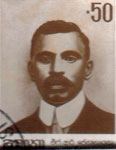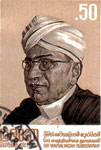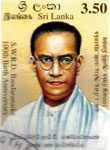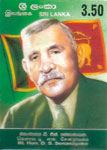The Ceylon National Congress formed in 1919 kept on pressing for constitutional reforms and self-government. The national leaders were very active in the 1920s demanding an elected majority in the Legislative Council.
F. R. Senanayake (1882 – 1926) a lawyer by profession, who gave up his practice and joined the temperance movement around 1912, saw the possibility of transforming the movement into an effective political organisation. He was among the Buddhist leaders who were taken
into custody after the 1915 riots. After he was released, he played a prominent role in sending
E. W. Perera to England to make direct representations to the British Government. He himself was in the 1920 delegation to England.
As the seniors were passing away, the younger generation was taking over the affairs of the National Congress. At the seventh sessions of the Congress in December 1925,
S. W. R. D. Bandaranaike seconded a resolution moved by C. E. Corea that steps should be taken to ensure a full measure of self-government at the next revision of the Constitution.
 |
 |
 |
 |
F. R. Senanayake
|
S. W. R. D. Bandaranaike
|
D. S. Senanayake
|
Sir Waityalingam Duraiswamy |
C. W. W. Kannangara – better known as ‘Father of Free Education’,
A. F. (later Sir Francis) Molamure, Speaker of the first Parliament and
D. S. Senanayake who was to be the first Prime Minister of Independent Sri Lanka were among them.
C. W. W. Kananangara
(1884 –1969) won a bye-election for the Southern Province seat in the Legislative Council in 1923 followed by victories at the general elections in 1924 and 1928. A founder member of the Congress, he was President in
1931 – 32. Elected to the State Council in 1931 and 1936, he served as Minister of Education for 17 years introducing extensive reforms in the education sector. He abolished the two-tiered school system with English for the privileged urban classes and vernacular for the rural masses.
The mother tongue was introduced as the medium of instruction, the curriculum was revised with a vocational and cultural bias, upgraded Pirivena education, and inaugurated the University. He established a series of Central Schools modelled on Royal College which took secondary education virtually to the door step of the rural child. His crowning achievement was Free Education when he introduced legislation to end fees for tuition from school to university amidst bitter opposition from several senior political colleagues.
S. W. R. D. Bandaranaike (1899 –1959) was elected Congress President in 1932 and the Congress decided to try out the Donoughmore Constitution (it set up the State Council which elected 50 members on the basis of full adult suffrage, three officers of state and eight nominated by the Governor) and after some time to ask for full self-government and accept nothing less. Bandaranaike was elected to the Colombo Municipal Council in 1927 and to the first State Council in 1931 becoming Minister of Local Administration. He founded the Sinhala Maha Sabha in 1937 and was involved in the formation of the United National Party (UNP) which won the 1947 General Election to the first Parliament and formed the government.
He was Leader of the House and Minister of Health until 1952, when he resigned and formed the Sri Lanka Freedom Party (SLFP) and led the Mahajana Eksath Peramuna (MEP) – a coalition with several parties, to victory at the 1956 general election and became Prime Minister. He introduced Sinhala as the official language, nationalised the bus services, took over the British bases and supported several measures which were beneficial to the common man. He was the victim of modern
Sri Lanka’s first political assassination when he was shot by a Buddhist monk at his Rosmead Place home.
D. S. Senanayake (1884 – 1952) was another key figure in the Congress who also took a lead role in the temperance movement with brother F. R. He too was arrested following the 1915 riots. He served as Minister of Agriculture from the inception of the State Council (1931) and was the leader of the Board of Ministers in the pre-independence Council following the retirement of Sir Baron Jayatilaka from politics in 1942. A draft prepared by him and presented to the British administration in 1944 formed the basis for the Independence Act. After forming the UNP in 1946, he led the party to victory at the 1947 general election becoming Prime Minister. He was keen on developing the dry zone and started several irrigation projects to provide water for food crops. Peasants were settled in colonisation schemes. He is best remembered for the Minneriya tank and the multi-purpose Gal Oya project (a massive tank was named Senanayake Samudra) – the largest irrigation scheme undertaken since the time of the tank-building Polonnaruwa kings.
Sir Waitialingam Duraiswamy was the founder secretary of the Jaffna Association which was created to promote the political advancement of the country. In 1921, in the first elections on a provincial basis he represented the Northern Province in the Legislative Council and was later returned uncontested in 1924. An ardent advocate of communal harmony and understanding, he was in the forefront of the fight for independence. In 1936 he was elected untested to the State Council and was elected Speaker which post he held for eleven years.
|





